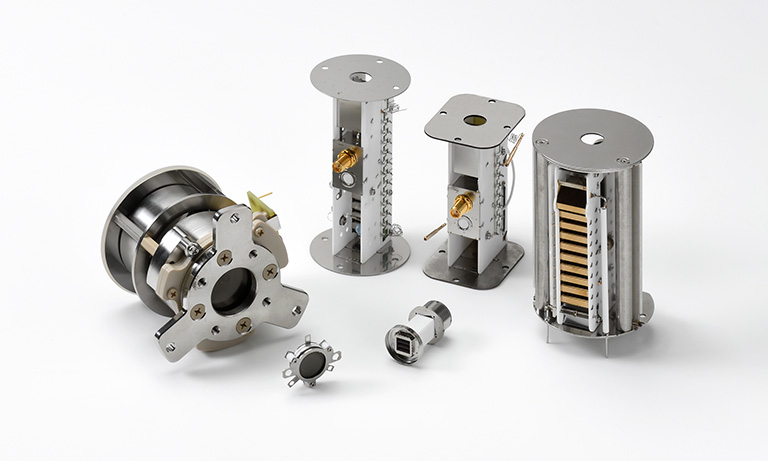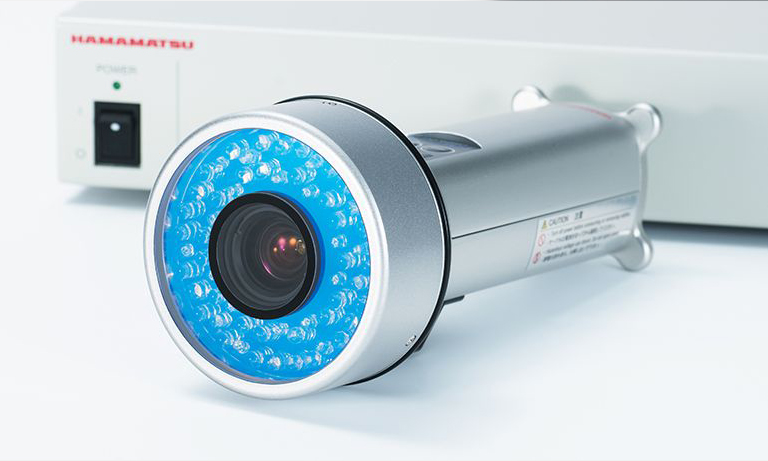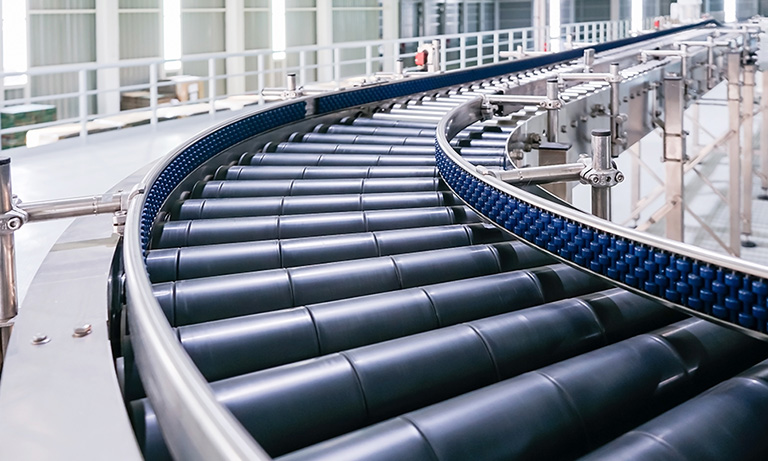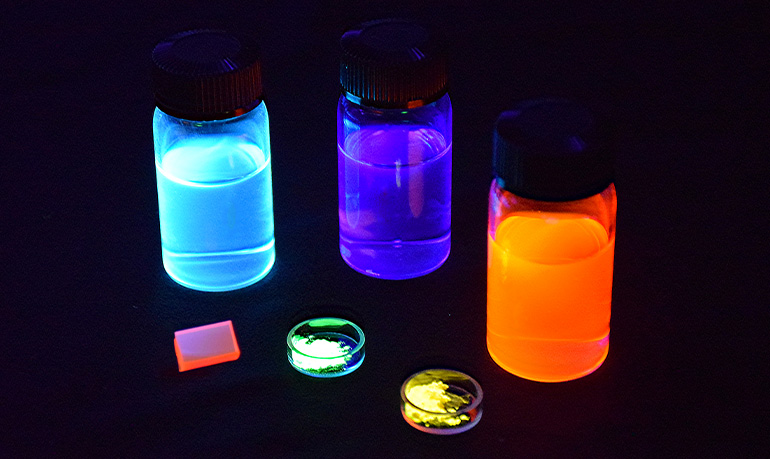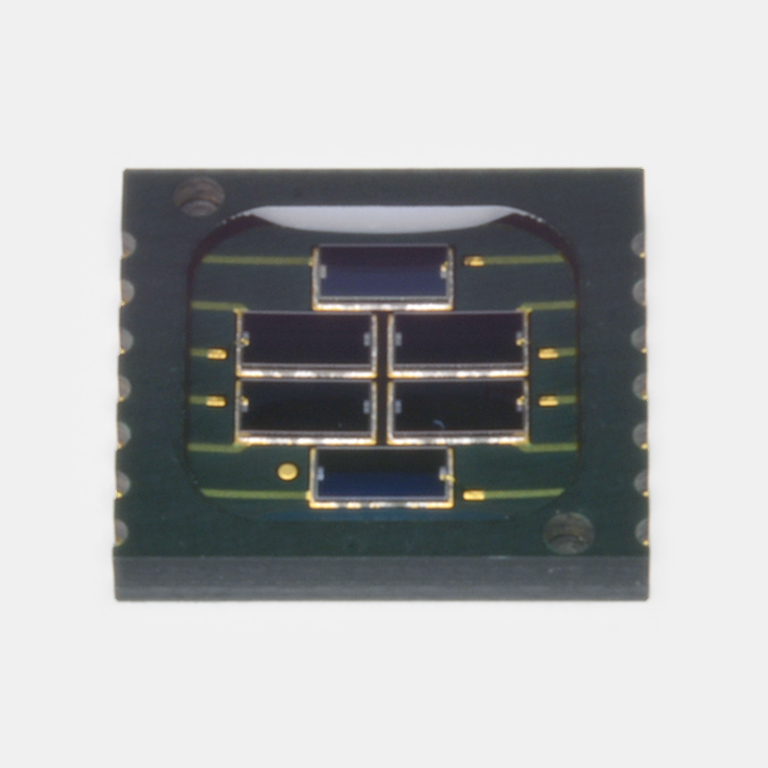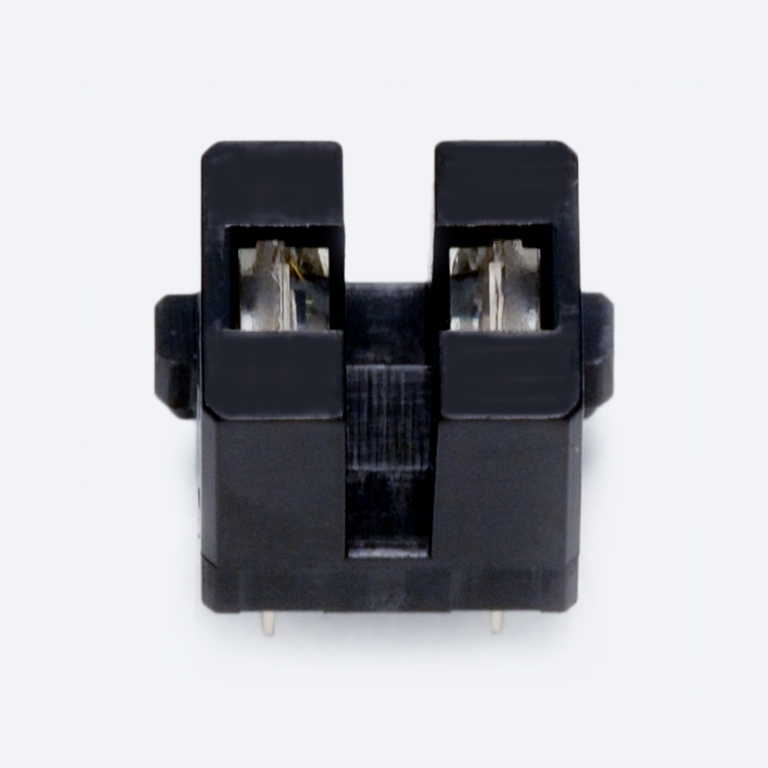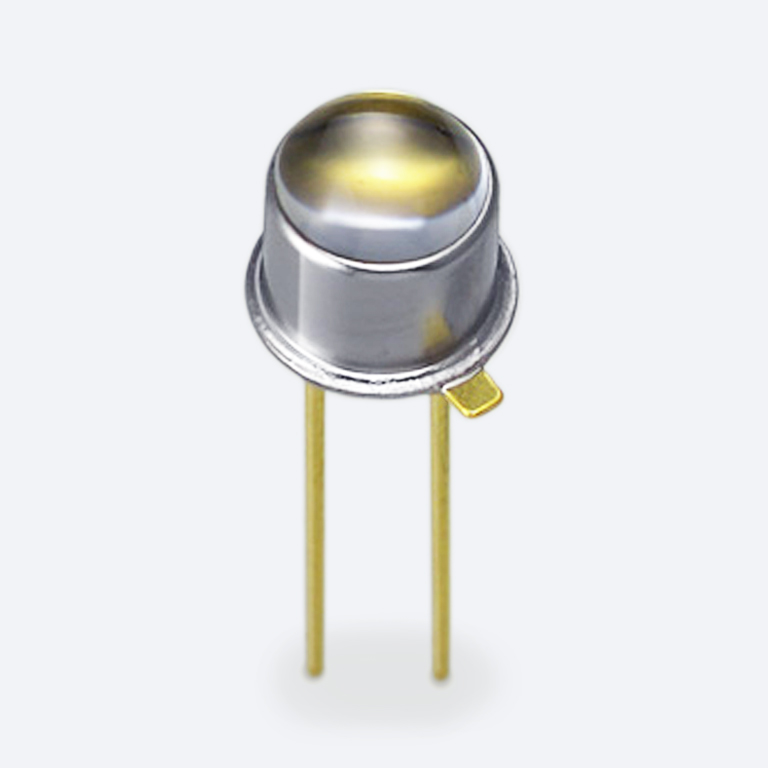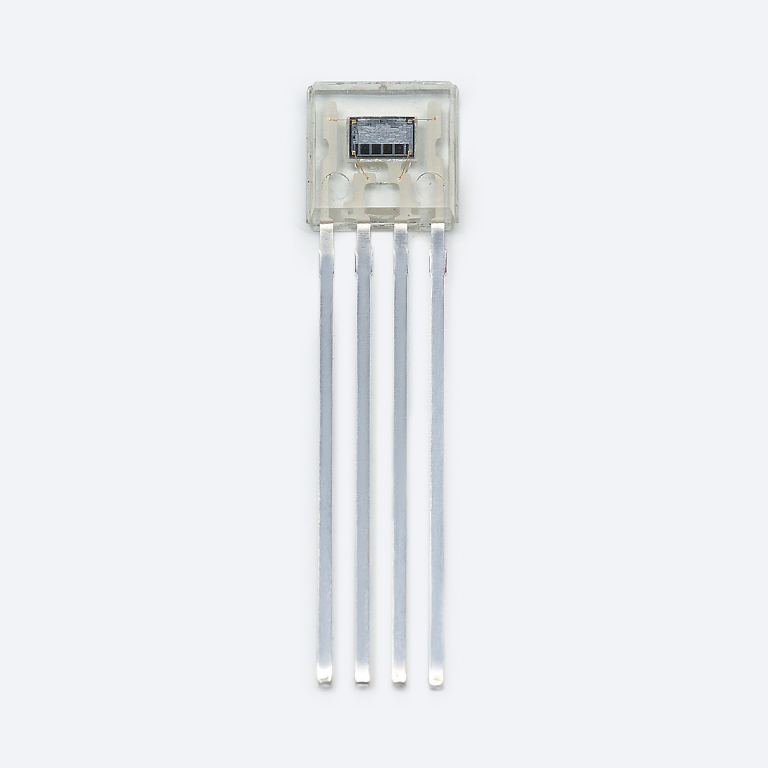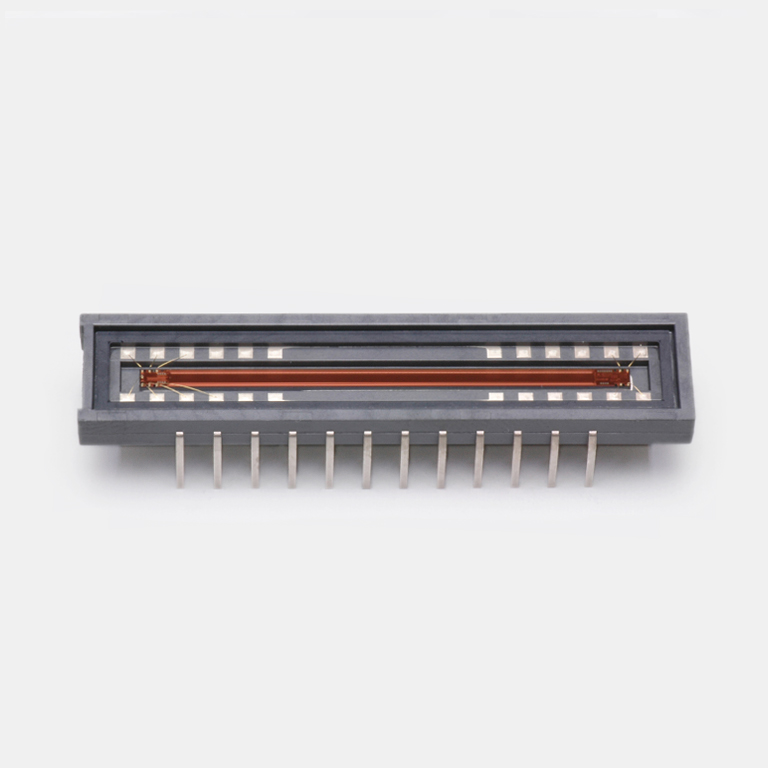Japan (EN)
Select your region or country.


Encoder
In the joints of industrial robots such as machine tools, numerous servo motors are used to accurately control their operations. To detect the direction, angle and speed rotation of servo motors, optical encoders are widely used. Hamamatsu manufactures Si photodiodes, photo ICs, image sensors, LEDs, and so on that are suitable for optical encoders and also provides products that meet customer's needs.
■ Structure of servo motor
■ Configuration example
What are optical rotary encoders?
There are two types of optical rotary encoders. One is "transmission type" and the other one is "reflection type". In the transmission type, a code wheel engraved with fine slits is placed between a light emitter and a photosensor, and the rotation angle is detected from the on/off signal made by transmitting/blocking light. In the reflection type, the light emitter and the photosensor are placed on the same side as the code wheel and the rotation angle is detected from the reflection/non-reflection of light.
To ensure a highly accurate encoder, the light emitter is required performance to emit light uniformly. Also, the photosensor needs a high-speed response, as well as a chip arrangement that supports complicated slit patterns.
Hamamatsu can provide light emitters and photosensors for both types of encoders (transmission type / refrection type).
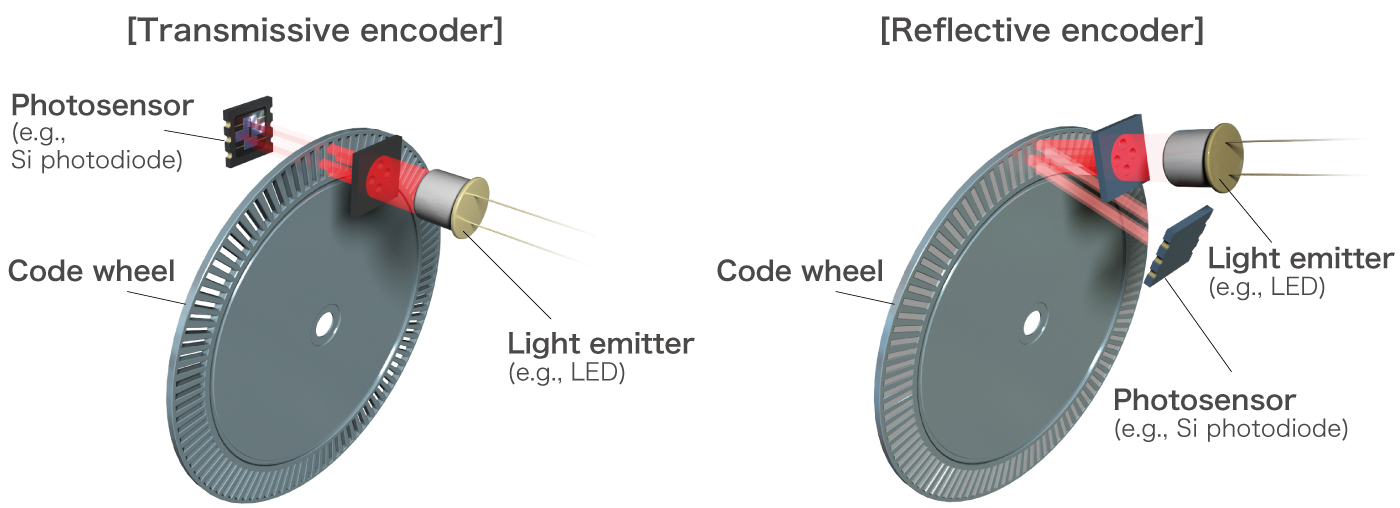
Photodiodes for encoders
Features of Hamamatsu photodiodes for encoders
1. Unique semiconductor process
Using on Hamamatsu unique semiconductor process technology, we manufacturer high-sensitivity, low-noise, highly-reliability photodiodes that are suitable for encoders. Further, we have a proven track record of manufacturing numerous industrial photodiodes.
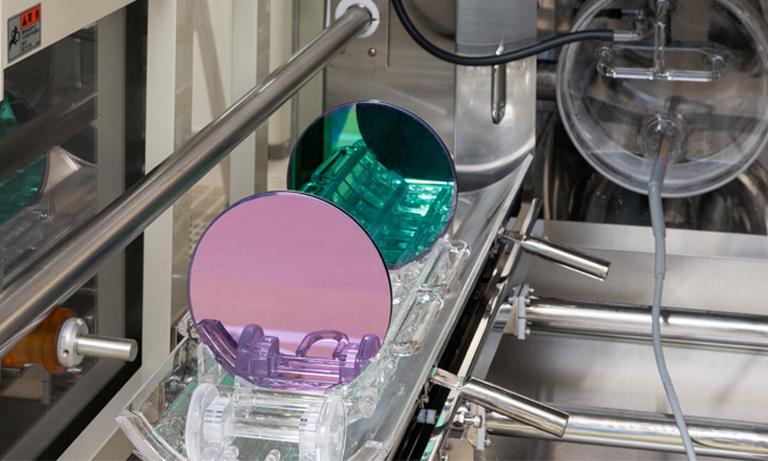
2. Optimum sensitive design for users' applications
Hamamatsu can manufacture photodiodes with high sensitivity for the wavelength of the light source to be used, from visible light to near infrared light.
A higher S/N can be expected by optimizing the sensitivity for the LED used in the optical encoder.
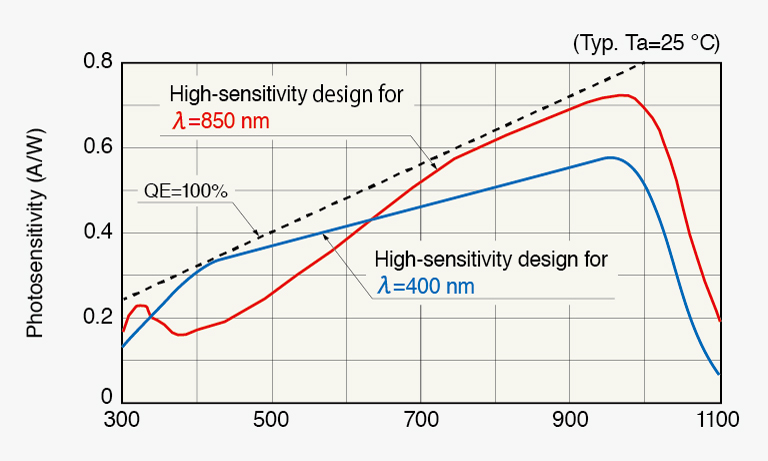
3. Extensive package/mounting technology
Hamamatsu supplies various package products for many applications including automotive, industrial, and consumer.
we can suggest a variety of package/mounting solutions such as the combined mounting of the LED and photodiode, and the miniaturization of photodiode packages.
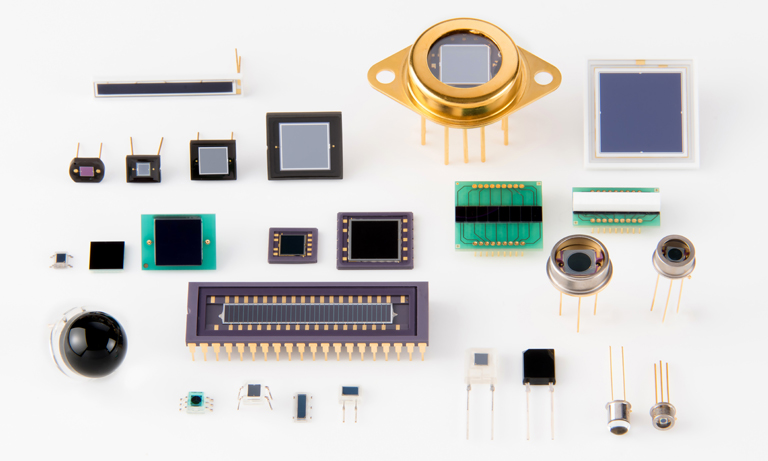
Package lineup
■ COB package
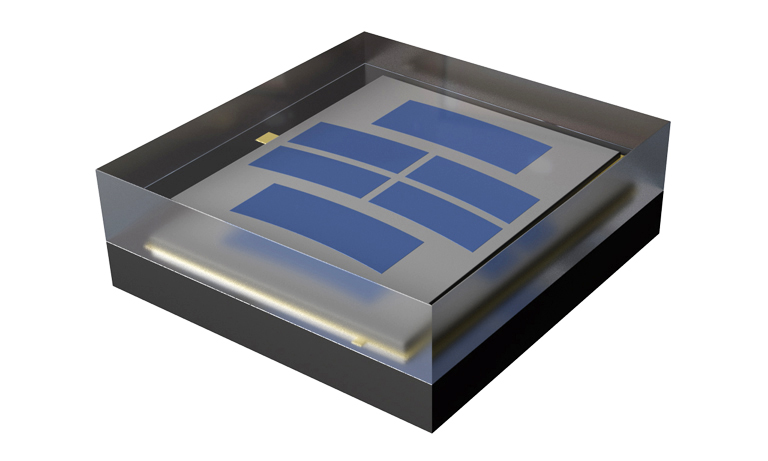
- Operating temperature: -40 to +100 ℃
- Storage temperature: -40 to +100 ℃
- Packing method: 1000 pcs/reel
■ Chip carrier package
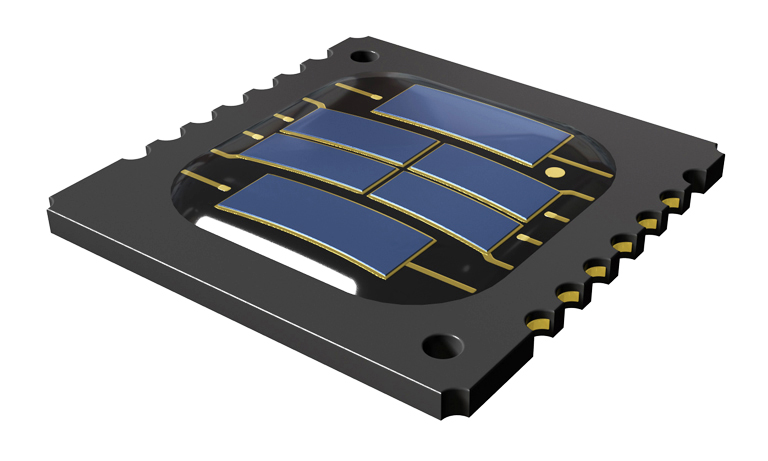
- Operating temperature: -40 to +100 ℃
- Storage temperature: -40 to +100 ℃
- Packing method: 100 pcs/tray or 1000 pcs/tray
Photo ICs for encoders
Customization
Hamamatsu offers customized photo ICs according to the customers' encoder specifications. Below are our track record and examples of customizations of photo ICs for reflective encoders.
- Monolithic structure of photodiode and peripheral circuit ⇒ Contributes to reduce the number of parts and mounting space on the customer's side
- Multifunctionalization using I2C ⇒ Enables multifunctionalization such as electron volume
- Built-in LED and LED driver ⇒ Enables light receiving and emitting photo ICs with LEDs placed in the center of the chip
- Variation correction for variations in reference values (current, voltage) by trimming
Example 1: Example of photo ICs intergating the photodiode and LED (monolithic structure)
This is an example of Hamamatsu photo ICs integrating a photodiode and peripheral circuit that were discretely discretely configured by a customer.
■ Block diagram
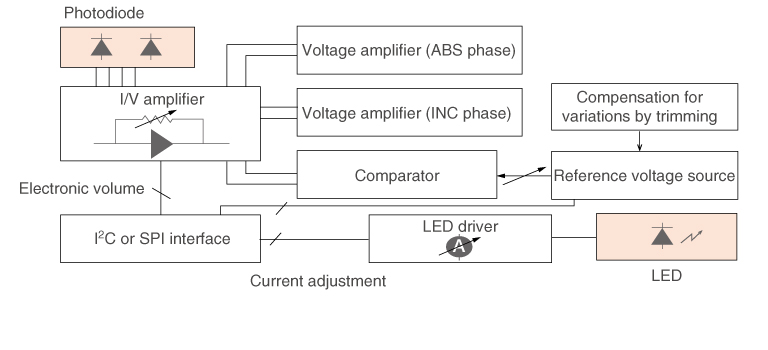
■ Product image
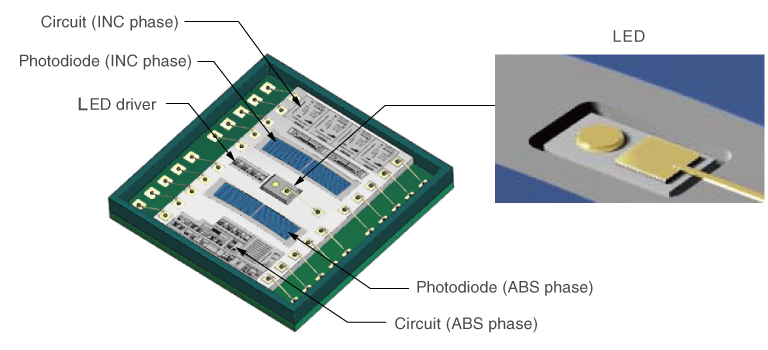
■ Image of LED mounting (cross section)

Example 2: Example of instrumentation amplifier (1/f noise, thermal noise considered)
Noise reduction has been achieved through circuit configuration that measures against I/F noise and thermal noise.

Example of special processing applied to Si photodiodes and photo ICs (customization)
Through-hole formation (MEMS processing)
Through-holes can be formed on Si photodiode chips by applying MEMS technology. This allows to mount a point source LED (current confinement type LED) used in reflective encoders inside a hole of a Si photodiode chip. Further, it is possible to align the height of the LED emitter surface and photosensitive area surface of the Si photodiode by adjusting the thickness of Si photodiode chip.
■ Through-hole example
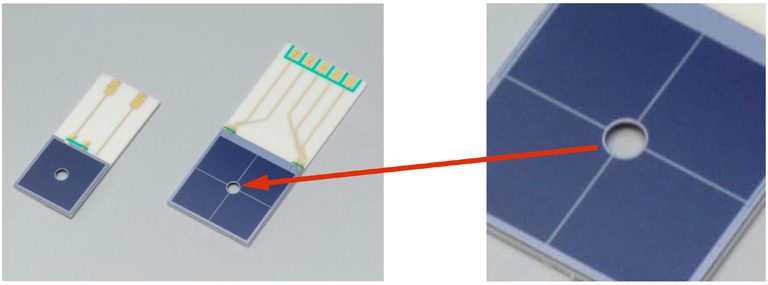
■ Example of an LED mounted inside a through-hole of a Si photodiode
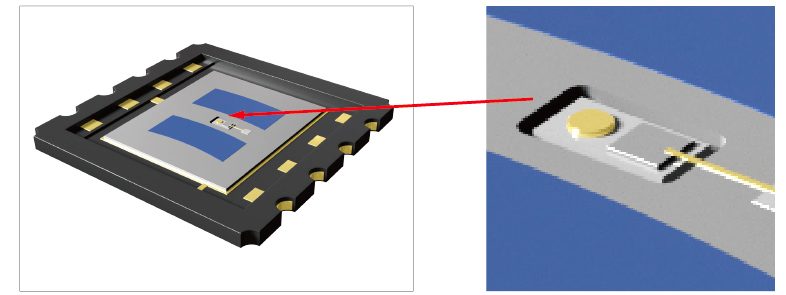
Low-reflectance light-shielding film
The reflectance of metal wiring and parts other than the photosensitive area can be reduced by applying light-shielding film on the surface of the Si photodiode through special processing. As a result, the S/N ratio can be improved.
■ Reflectance vs. wavelength (reference value)
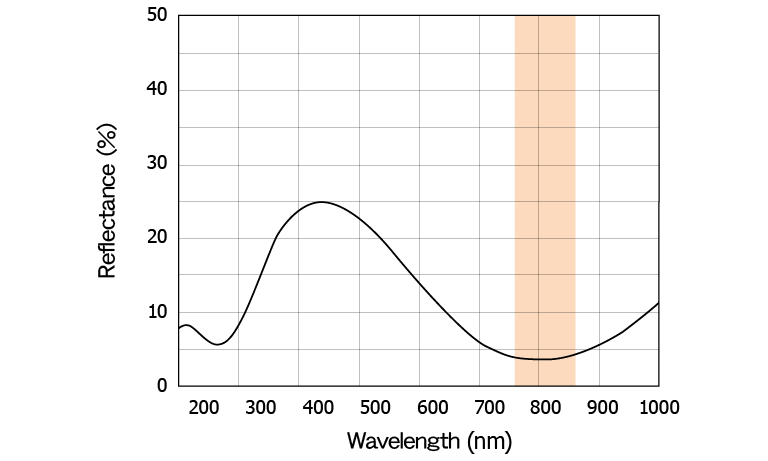
The reflectance of near infrared light often used in optical encoders is reduced significantly.
■ Example of Si photodiode with light-shielding film
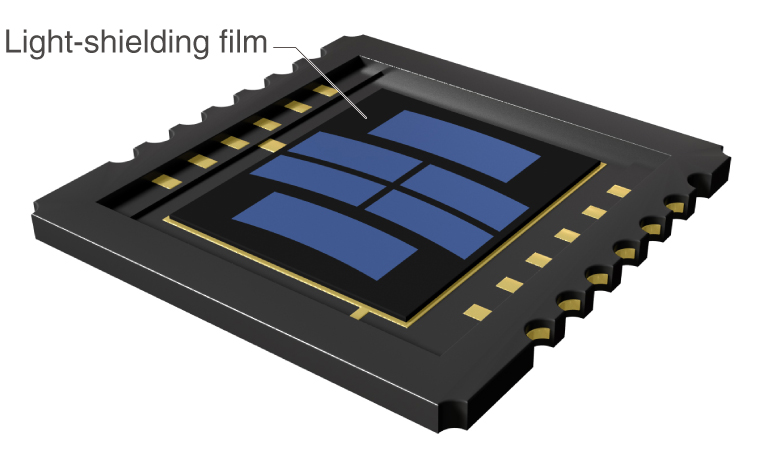
Applying image sensors to linear encoders
CMOS linear image sensors with rectangular pixels, high line rate, and a global shutter function are appropriate for absolute track reading of linear encoders.
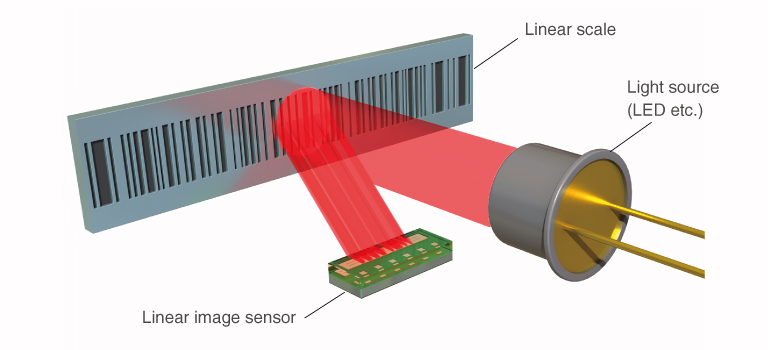
Various product formats
Hamamatsu offers image sensors with various numbers of pixels and pixel sizes, according to the resolution and response speed needed for encoders. Number of pixels from 64 ch to 4096 ch are available.
Pixel size, number of pixels, and package types are all customizable. If you have any requests, please contact our sales.
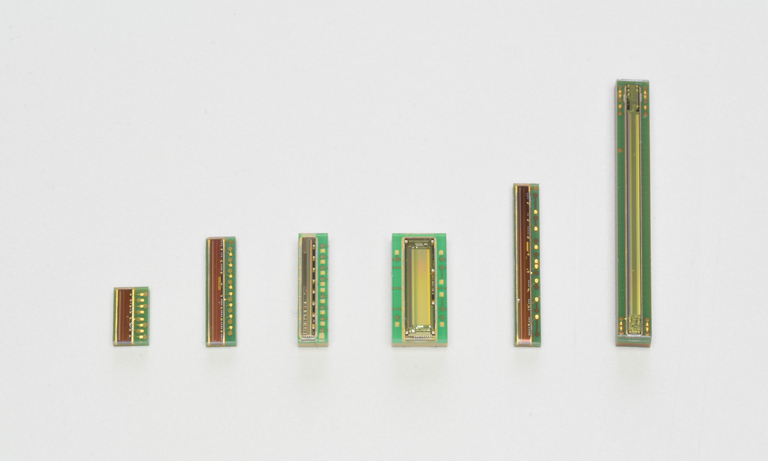
- Rectangular pixel (7 × 200 µm)
- Line rate
1024 ch all-pixel readout: 34 kHz
260 ch partial readout: 100 kHz - Global shutter
- 12-bit digital output
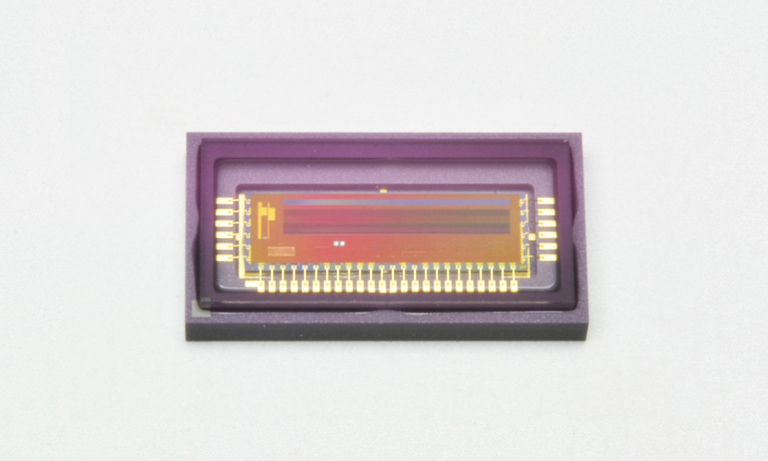
LEDs for encoders
Features of Hamamatsu LEDs for encoders
1. Unique semiconductor process
Hamamatsu has unique semiconductor process technology and manufactures high-light output and high-reliability LED suitable for light emitters of encoders.
2. Various product lineup
Hamamatsu produces and provides various types of LEDs for a wide variety of applications including automotive, industrial, and consumer. For optical encoders, we provide collimated LEDs that can irradiate low-focus/dispersion, uniform collimated light suitable for constructing high accuracy encoders.
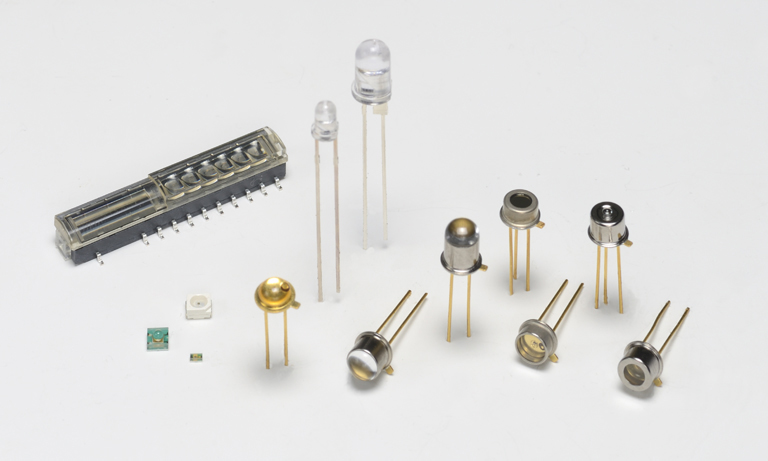
Improvement of reliability by improving the crystal structure: Point source LEDs (Current confinement type LEDs)
Higher reliability than previous LEDs was achieved by improving the crystal structure of the point source LED chip. Further, it is possible to design light emission diameters that meet customer needs.
* Hamamatsu LEDs are normally provided as package products. If you wish to request a bare chip product, please contact our sales.
■ Example of a point source LED chip design (unit: μm)
■ Example of a point source LED
■ Effect of stray light countermeasures due to side light shading
Package lineup
■ High-reliability metal package
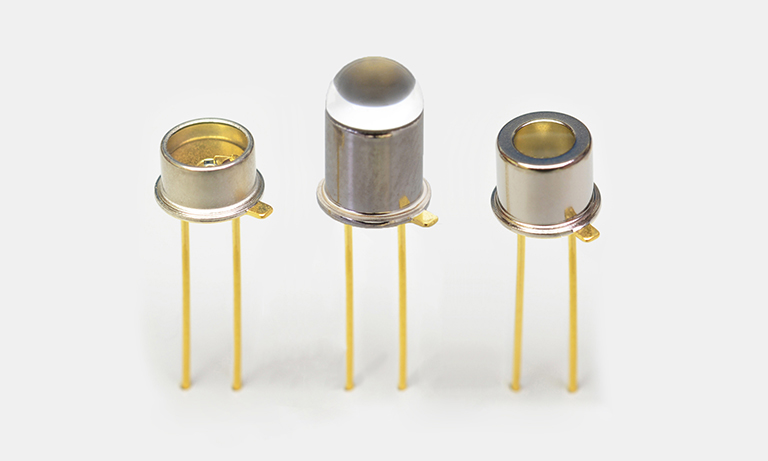
- Operating temperature: -30 to +85 ℃
- Storage temperature: -40 to +100 ℃
- Packing method: 200 pcs/bag
■ High reliability, high collimation metal package
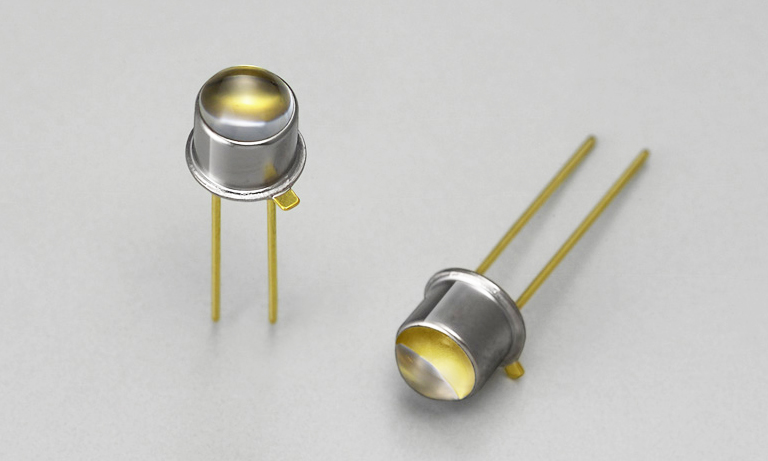
- Operating temperature: -30 to +105 ℃
- Storage temperature: -40 to +105 ℃
- Packing method: 100 pcs/bag
■ Compact, narrow directivity COB package
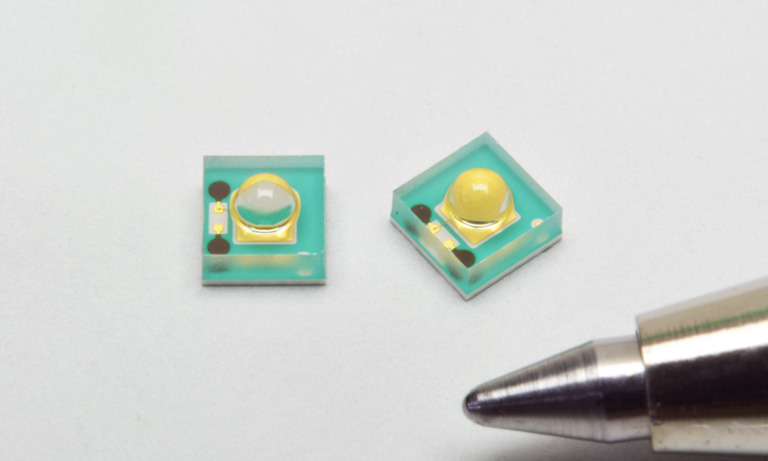
- Operating temperature: -30 to +85 ℃
- Storage temperature: -40 to +100 ℃
- Packing method: 2000 pcs/reel
- Confirmation
-
It looks like you're in the . If this is not your location, please select the correct region or country below.
You're headed to Hamamatsu Photonics website for JP (English). If you want to view an other country's site, the optimized information will be provided by selecting options below.
In order to use this website comfortably, we use cookies. For cookie details please see our cookie policy.
- Cookie Policy
-
This website or its third-party tools use cookies, which are necessary to its functioning and required to achieve the purposes illustrated in this cookie policy. By closing the cookie warning banner, scrolling the page, clicking a link or continuing to browse otherwise, you agree to the use of cookies.
Hamamatsu uses cookies in order to enhance your experience on our website and ensure that our website functions.
You can visit this page at any time to learn more about cookies, get the most up to date information on how we use cookies and manage your cookie settings. We will not use cookies for any purpose other than the ones stated, but please note that we reserve the right to update our cookies.
1. What are cookies?
For modern websites to work according to visitor’s expectations, they need to collect certain basic information about visitors. To do this, a site will create small text files which are placed on visitor’s devices (computer or mobile) - these files are known as cookies when you access a website. Cookies are used in order to make websites function and work efficiently. Cookies are uniquely assigned to each visitor and can only be read by a web server in the domain that issued the cookie to the visitor. Cookies cannot be used to run programs or deliver viruses to a visitor’s device.
Cookies do various jobs which make the visitor’s experience of the internet much smoother and more interactive. For instance, cookies are used to remember the visitor’s preferences on sites they visit often, to remember language preference and to help navigate between pages more efficiently. Much, though not all, of the data collected is anonymous, though some of it is designed to detect browsing patterns and approximate geographical location to improve the visitor experience.
Certain type of cookies may require the data subject’s consent before storing them on the computer.
2. What are the different types of cookies?
This website uses two types of cookies:
- First party cookies. For our website, the first party cookies are controlled and maintained by Hamamatsu. No other parties have access to these cookies.
- Third party cookies. These cookies are implemented by organizations outside Hamamatsu. We do not have access to the data in these cookies, but we use these cookies to improve the overall website experience.
3. How do we use cookies?
This website uses cookies for following purposes:
- Certain cookies are necessary for our website to function. These are strictly necessary cookies and are required to enable website access, support navigation or provide relevant content. These cookies direct you to the correct region or country, and support security and ecommerce. Strictly necessary cookies also enforce your privacy preferences. Without these strictly necessary cookies, much of our website will not function.
- Analytics cookies are used to track website usage. This data enables us to improve our website usability, performance and website administration. In our analytics cookies, we do not store any personal identifying information.
- Functionality cookies. These are used to recognize you when you return to our website. This enables us to personalize our content for you, greet you by name and remember your preferences (for example, your choice of language or region).
- These cookies record your visit to our website, the pages you have visited and the links you have followed. We will use this information to make our website and the advertising displayed on it more relevant to your interests. We may also share this information with third parties for this purpose.
Cookies help us help you. Through the use of cookies, we learn what is important to our visitors and we develop and enhance website content and functionality to support your experience. Much of our website can be accessed if cookies are disabled, however certain website functions may not work. And, we believe your current and future visits will be enhanced if cookies are enabled.
4. Which cookies do we use?
There are two ways to manage cookie preferences.
- You can set your cookie preferences on your device or in your browser.
- You can set your cookie preferences at the website level.
If you don’t want to receive cookies, you can modify your browser so that it notifies you when cookies are sent to it or you can refuse cookies altogether. You can also delete cookies that have already been set.
If you wish to restrict or block web browser cookies which are set on your device then you can do this through your browser settings; the Help function within your browser should tell you how. Alternatively, you may wish to visit www.aboutcookies.org, which contains comprehensive information on how to do this on a wide variety of desktop browsers.
5. What are Internet tags and how do we use them with cookies?
Occasionally, we may use internet tags (also known as action tags, single-pixel GIFs, clear GIFs, invisible GIFs and 1-by-1 GIFs) at this site and may deploy these tags/cookies through a third-party advertising partner or a web analytical service partner which may be located and store the respective information (including your IP-address) in a foreign country. These tags/cookies are placed on both online advertisements that bring users to this site and on different pages of this site. We use this technology to measure the visitors' responses to our sites and the effectiveness of our advertising campaigns (including how many times a page is opened and which information is consulted) as well as to evaluate your use of this website. The third-party partner or the web analytical service partner may be able to collect data about visitors to our and other sites because of these internet tags/cookies, may compose reports regarding the website’s activity for us and may provide further services which are related to the use of the website and the internet. They may provide such information to other parties if there is a legal requirement that they do so, or if they hire the other parties to process information on their behalf.
If you would like more information about web tags and cookies associated with on-line advertising or to opt-out of third-party collection of this information, please visit the Network Advertising Initiative website http://www.networkadvertising.org.
6. Analytics and Advertisement Cookies
We use third-party cookies (such as Google Analytics) to track visitors on our website, to get reports about how visitors use the website and to inform, optimize and serve ads based on someone's past visits to our website.
You may opt-out of Google Analytics cookies by the websites provided by Google:
https://tools.google.com/dlpage/gaoptout?hl=en
As provided in this Privacy Policy (Article 5), you can learn more about opt-out cookies by the website provided by Network Advertising Initiative:
http://www.networkadvertising.org
We inform you that in such case you will not be able to wholly use all functions of our website.
Close











